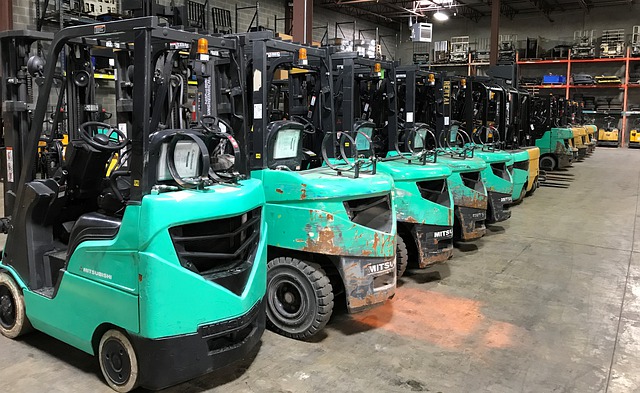When talking about a forklift operation, ensuring efficiency in daily deliveries is just one of the daily challenges faced by managers of different companies, regardless of size or segment of activity. Above that, there is one item that prevails: security, especially when there are people involved in the process.
Due to the nature of the employee’s work activity released by the Social Security Department.
Also according to the survey, it is worth mentioning that within the category “typical accidents”, the second highest incidence of accidents occurred with the so-called “transverse function workers” (13.82%), which include drivers of lifting equipment and cargo movement. The industry, in this context, accounted for 37.10% of all incident records, second only to the service sector (62.50%).
Safety, especially from the point of view of an operation with combustion forklifts, becomes a central issue.
For the specialist, there are many points of attention, but three issues converge within the various risk situations that a forklift operation can present, namely: individual safety, grounding and supply.
Safety in forklift Operation:
In general, the operation with a combustion forklift deals with individual safety under two main keys: ergonomics and the guarantee of protection of the individual against the dangerous scenario, very characteristic within the industry.
With regard to ergonomics, three principles must be considered view: strength, posture and repeatability.
Without the necessary care, operations with bulk LPG forklifts, for example, as they require the constant change of containers for refueling, can violate these three principles and cause from punctual postural discomfort to more serious damage to the operator’s health. Forklift Repair Houston Tx
Still in terms of individual safety, another critical point is the identification of the driver responsible for the supply. Points out, this person must be identified and trained for that role. “An establishment may have a number of forklift operators, but not all of them are responsible for supplying them. In general, there is a person appointed for this function and they receive a premium for that”, he explains.
As for grounding, the process itself is imperative. “The greatest risks of accidents in the supply process are electrical discharges.
Finally, there is the issue of the supply process itself, which brings a scenario of repeating step by step that, if done carelessly, can cause leaks or other accidents.
Forklifts x Security:
All these points mentioned by experts are the most common to the operation of combustion forklifts, whether in bulk or pitstop models. Some solutions available on the market already provide ways to address them, but not with the intelligence that the security context requires.
“The standard pitstop, for example, has grounding. But it does not recognize it, that is. It does not have the technology to differentiate whether the grounding was done correctly or not.
Came to transform the market in this sense. The solution is a supply pitstop for LPG forklifts and brings, in a simple and intuitive way, more safety to forklift operations, delivering important differentials in the three key principles.
1) Individual safety: ergonomics and operator identification:
Just because it is a already eliminates the need to change cylinders at the time of filling, bringing more comfort to the operator in terms of ergonomics. As for the hazard premium mentioned earlier by The solution helps industrial customers control this demand through RFID technology (Radio-Frequency Identification).
“Our system only authorizes the procedure after identifying the person who is in fact qualified to carry out the supply”, explains Santos.
With this, two gains are guaranteed: (1) only the person responsible for the supply will be released by the system to perform the procedure, increasing individual safety; and (2) by registering the ID of the person in charge in the system, it is also possible to comply with governance and compliance guidelines, mitigating any legal disagreement regarding claims or additional risk of the operator.
2) Grounding: interlock system:
Once identified and authorized through RFID system forces the operator to ground the equipment. “Only and only after that does the system release the supply and, with that, we were able to greatly increase the level of security,” explains Santos, adding that the system is equipped with recognition technology that identifies whether the grounding was done correctly.
3) Supply: assisted operation panel:
After completing the two previous steps. This is ready for the fueling process itself. In this step, the technology embedded in the system ensures that the operator fulfills all the necessary items to supply safely.
“The solution has a safety-assisted operation panel, which shows the operator the step-by-step procedure. More than that, it forces him to press ‘confirm’ at each step”, summarizes Santos.
In this way, it is possible to guarantee that a merely routine task, such as filling the forklift, which could easily be carried out “on automatic”, is carried out with the caution and extra attention that the procedure requires.
Safety culture is essential:
Having the technologies used in favor of security is a critical point in building an operational scenario that brings protection to everyone involved in the process. But still, it is necessary to go further. More than numbers. Survey highlights the importance of having a culture focused on safety.
“Building a culture of safety is essential. We are dealing with heavy equipment, which moves quickly, transports cargo.
The expert points out that creating a strong safety culture is more than just ensuring that the machinery operator is protected and properly trained to follow standard regulations.
It is also to ensure that all company employees are aware of the risks, as well as the surroundings where the machine is operating are covered by the protection guidelines, with full delimitation.
